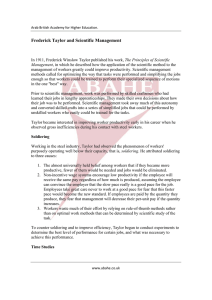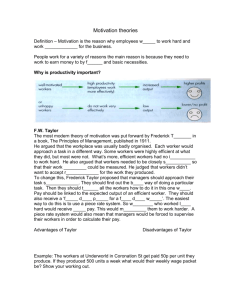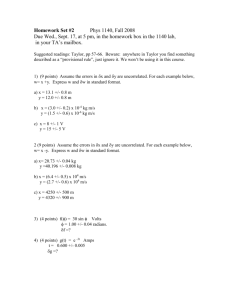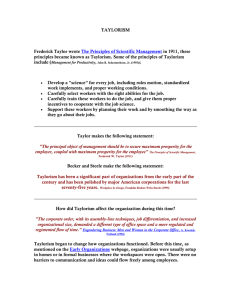Frederick Taylor and Scientific Management
advertisement
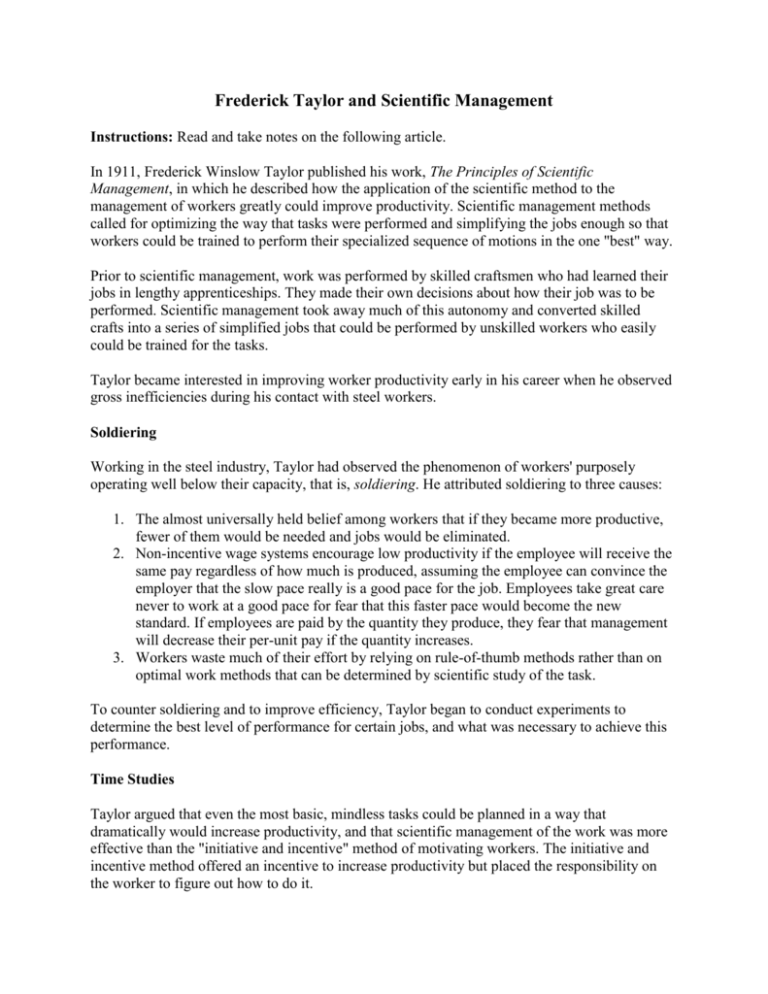
Frederick Taylor and Scientific Management Instructions: Read and take notes on the following article. In 1911, Frederick Winslow Taylor published his work, The Principles of Scientific Management, in which he described how the application of the scientific method to the management of workers greatly could improve productivity. Scientific management methods called for optimizing the way that tasks were performed and simplifying the jobs enough so that workers could be trained to perform their specialized sequence of motions in the one "best" way. Prior to scientific management, work was performed by skilled craftsmen who had learned their jobs in lengthy apprenticeships. They made their own decisions about how their job was to be performed. Scientific management took away much of this autonomy and converted skilled crafts into a series of simplified jobs that could be performed by unskilled workers who easily could be trained for the tasks. Taylor became interested in improving worker productivity early in his career when he observed gross inefficiencies during his contact with steel workers. Soldiering Working in the steel industry, Taylor had observed the phenomenon of workers' purposely operating well below their capacity, that is, soldiering. He attributed soldiering to three causes: 1. The almost universally held belief among workers that if they became more productive, fewer of them would be needed and jobs would be eliminated. 2. Non-incentive wage systems encourage low productivity if the employee will receive the same pay regardless of how much is produced, assuming the employee can convince the employer that the slow pace really is a good pace for the job. Employees take great care never to work at a good pace for fear that this faster pace would become the new standard. If employees are paid by the quantity they produce, they fear that management will decrease their per-unit pay if the quantity increases. 3. Workers waste much of their effort by relying on rule-of-thumb methods rather than on optimal work methods that can be determined by scientific study of the task. To counter soldiering and to improve efficiency, Taylor began to conduct experiments to determine the best level of performance for certain jobs, and what was necessary to achieve this performance. Time Studies Taylor argued that even the most basic, mindless tasks could be planned in a way that dramatically would increase productivity, and that scientific management of the work was more effective than the "initiative and incentive" method of motivating workers. The initiative and incentive method offered an incentive to increase productivity but placed the responsibility on the worker to figure out how to do it. To scientifically determine the optimal way to perform a job, Taylor performed experiments that he called time studies, (also known as time and motion studies). These studies were characterized by the use of a stopwatch to time a worker's sequence of motions, with the goal of determining the one best way to perform a job. QuickTime™ and a decompressor are needed to see this picture. The following are examples of some of the time-and-motion studies that were performed by Taylor and others in the era of scientific management. Pig Iron If workers were moving 12 1/2 tons of pig iron per day and they could be incentivized to try to move 47 1/2 Motion study of an iron worker tons per day, left to their own wits they probably would become exhausted after a few hours and fail to reach their goal. However, by first conducting experiments to determine the amount of resting that was necessary, the worker's manager could determine the optimal timing of lifting and resting so that the worker could move the 47 1/2 tons per day without tiring. Not all workers were physically capable of moving 47 1/2 tons per day; perhaps only 1/8 of the pig iron handlers were capable of doing so. While these 1/8 were not extraordinary people who were highly prized by society, their physical capabilities were well-suited to moving pig iron. This example suggests that workers should be selected according to how well they are suited for a particular job. The Science of Shoveling In another study of the "science of shoveling", Taylor ran time studies to determine that the optimal weight that a worker should lift in a shovel was 21 pounds. Since there is a wide range of densities of materials, the shovel should be sized so that it would hold 21 pounds of the substance being shoveled. The firm provided the workers with optimal shovels. The result was a three to four fold increase in productivity and workers were rewarded with pay increases. Prior to scientific management, workers used their own shovels and rarely had the optimal one for the job. Bricklaying Others performed experiments that focused on specific motions, such as engineer Frank Gilbreth's bricklaying experiments that resulted in a dramatic decrease in the number of motions required to lay bricks. The husband and wife Gilbreth team used motion picture technology to study the motions of the workers in some of their experiments. The traditional method of laying bricks, even after 6,000 years, involved unnecessary stooping, walking and reaching. The time-consuming, tiring part of the job had been stooping 125 times per hour for brick and 125 times for mortar. By changing the location of the supplies and training the men to reduce unnecessary movements (ie. extra reaching), workers could lay more bricks, standing normally, and return home after a full day’s work not nearly as tired. Taylor's 4 Principles of Scientific Management After years of various experiments to determine optimal work methods, Taylor proposed the following four principles of scientific management: 1. Replace rule-of-thumb work methods with methods based on a scientific study of the tasks. 2. Scientifically select, train, and develop each worker rather than passively leaving them to train themselves. 3. Cooperate with the workers to ensure that the scientifically developed methods are being followed. 4. Divide work nearly equally between managers and workers, so that the managers apply scientific management principles to planning the work and the workers actually perform the tasks. These principles were implemented in many factories, often increasing productivity by a factor of three or more. Henry Ford applied Taylor's principles in his automobile factories, and families even began to perform their household tasks based on the results of time and motion studies. Drawbacks of Scientific Management While scientific management principles improved productivity and had a substantial impact on industry, they also increased the monotony of work. The core job dimensions of skill variety, task identity, task significance, autonomy, and feedback all were missing from the picture of scientific management. While in many cases the new ways of working were accepted by the workers, in some cases they were not. The use of stopwatches often was a protested issue and led to a strike at one factory where "Taylorism" was being tested. Complaints that Taylorism was dehumanizing led to an investigation by the United States Congress. Despite its controversy, scientific management changed the way that work was done, and forms of it continue to be used today. Adapted from: Frederick W. Taylor: The Principles of Scientific Management, 1911 http://www.fordham.edu/halsall/mod/1911taylor.html http://www.netmba.com/mgmt/scientific/
